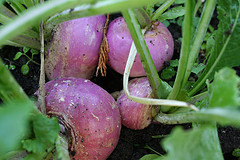Turnips
| Infobox on Turnips | |
|---|---|
| Example of Turnips |  |
| Freshness facts | |
| Optimum carrying temperature | 0°C to 1°C |
| Highest freezing point | -1,0°C |
| Acceptable product temp. at loading into containers | Max. 2°C above carrying temperature |
| Optimum humidity | 90% to 95% |
| Ventilation setting for containers | 10 m³/hr |
| Storage life | 4 to 5 months |
| Climacteric / non-climacteric | Non-climacteric |
| Ethylene production | Very low |
| Ethylene sensitivity | Low |
| Modified / controlled atmosphere | - |
| Potential benefits | - |
| Availability | |
| On demand | |
Turnips
Contents
Harvesting and Handling
Turnips have a small, white-fleshed root, often with the surface of the top-half purple, and hairy leaves. High quality turnips are firm, free of growth cracks, woodiness, rot, injury, and pithiness. Turnips are sold bunched with tops not less than 15 cm long, short-trimmed roots with tops not more than 10 cm long, and topped turnips with tops removed to not more than 2 cm.
Packaging turnips in perforated plastic bags helps keep the humidity high around the roots during marketing and reduces shrivelling. Dipping turnips in hot melted Paraffin Wax gives a glossy appearance and is of some value in reducing moisture loss during handling. However, waxing is primarily to aid in marketing and is not recommended before long-term storage.
Cooling and Storage
Topped turnips require storage conditions similar to those for topped carrots. Turnips in good condition can be expected to keep 4 to 5 months at 0°C and high relative humidity. At higher temperatures (5°C and above) decay will develop much more rapidly than at 0°C.
Turnips are not sensitive to chilling temperatures and should be stored as cold as possible to freezing. Storage at warmer temperatures, >5°C accelerates weight loss and development of soft rot.
Controlled atmosphere considerations
CA storage of turnip was reported to have had only a slight to no effect.
Storage disorders
Alternaria rot, Anthracnose, Bacterial soft rot, Black rot, Downy mildew, Fusarium, Leaf spot, Mosaic virus, Pythium rot, Rhizoctonia rot, Rust, Watery soft rot.











